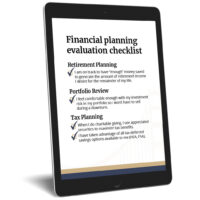
Volatility, Optimism, and Q1 Market Details
There’s no question we’re all living in unsettled times. Global citizens and the world economy are under stress, and uncertainty is heightened in all aspects of our lives. People are worried about their health, and that of family, friends, neighbors. Some have temporarily or permanently lost jobs or taken a hit to their income. Leaders of many companies are forced to make difficult decisions. Social distancing is impacting the human need to connect with others.
The impact on the global economy is significant, and the depth and magnitude of the downturn is unknown. Unemployment claims are rapidly increasing and estimates of global GDP decline are significant. The stock market and many portfolios are down sharply, with most asset classes in the red. Unprecedented economic intervention by the U.S. government, which will itself have long-term consequences, appear to have stabilized markets as of quarter-end, but uncertainty persists about the virus and its impact on health and the economy.
Planning for Volatility
Good planning, however, considers such outlier events, both in projections and portfolio construction. This market volatility falls within the range of possible short-term outcomes that are embedded in our planning assumptions. Each crisis has its own unpredictable and unique causes and trajectory. Some investors will naturally be tempted to capitulate and abandon their investment policy, turning paper losses into real locked-in losses. More than the market volatility itself, that flight response is the real risk to long-term goals.
We have lived through and helped people through many prior challenging periods before, and we’re here to guide you through this one as well. This too shall pass, even if the time frames aren’t clear.
Reason for Optimism
Despite the challenges above, there is also reason for optimism. Humans are amazingly resilient and creative. While scientists are rushing to find a vaccine and treatments, hundreds of millions of people around the world have united to control what they can by combatting the virus with social distancing, and it is showing results… sometimes the best offense is a good defense. Companies are rushing to produce more masks and ventilators, and in the meantime, states, individuals and countries with less need are shipping what they have to those in greater need.
People in isolation are maintaining and building face-to-face relationships with technology. People are trying to keep the economic engine running by safely supporting their local businesses as best they can. Portfolio rebalancing and tax-loss harvesting has already added significant value. And most impressively of all, the bravery and dedication of health care workers, food clerks and others are saving lives even ask they risk their own.
There is also more good news on the horizon, but it will require patience to see those headlines. Stay focused on taking care of the health of yourself and yours in the short-term. Stay focused on the long-term by riding out the economic and investment storm. Maintain hopeful but reasonable expectations in the short-term, in part by leaning away from predictions that this will all clear-up quickly. It’s better for everyone’s mental health to be realistic and possibly positively surprised than repeatedly disappointed.
Market recap details
As a member of Callan Independent Advisor Group, we have access to top quality research normally only available to multi-billion dollar entities. In this blog post, we want to share the latest Callan Market Recap with those of you who find the specifics of the first quarter of interest.
1Q2020 Quarterly Market Letter
Equity Markets
The S&P 500 Index plunged 19.6% in the first quarter, its worst quarterly return since the Global Financial Crisis. After falling more than 30% from peak to trough in just a few weeks, the Index rallied 20% going into quarter-end. Every sector experienced double-digit declines, with Information Technology (-11.9%), Consumer Staples (-12.7%), and Health Care (-12.7%) feeling the least pain. Financials (-31.9%) and Energy (-50.5%) fell the most. Financials were hurt by sharp declines in interest rates, and Energy’s performance reflected plummeting oil prices. Oil prices tumbled 66%, with WTI Crude ending the quarter at $20.48, down from roughly $60 at the start of the year. From a style viewpoint, growth significantly outperformed value (Russell 1000 Growth: -14.1%; Russell 1000 Value: -26.7%). Growth indices benefited from Technology exposure while Value struggled with relatively heavy weights in Energy and Financials. Large cap (Russell 1000: -20.2%) outperformed small cap (Russell 2000:-30.6%). Small value (Russell 2000 Value: -35.7%) saw the sharpest decline.
Global ex-U.S. equity indices fell sharply in the first quarter; the MSCI ACWI ex-USA Index dropped 23.4%. Across developed markets, Canada (-28%), the U.K. (-30%), and Australia (-34%) were among the worst performers while Japan (-17%) fared better, in relative terms. Modest appreciation of the U.S. dollar versus a basket of developed market currencies acted as a headwind for U.S. investors. As in the U.S., growth (MSCI ACWI ex-USA Growth: -18%) outperformed value (MSCI ACWI ex-USA Value: -29%). Also mirroring performance in the U.S., Health Care (-9%) was a top-performing sector while Energy (-38%) was the worst.
Emerging markets equities (MSCI EM: -23.6%) also sold off with currency depreciation being a key driver. Collectively, Latin American countries fell 46% in U.S. dollar terms and 32% in local currency terms. Russia dropped 36% in U.S. dollars (-22% local) and South Africa fell 41% (-24% local). India sank 32% (-27% local) while China performed relatively well, down only 10% in the quarter in U.S. dollar terms.
Fixed Income
U.S. Treasury yields fell to record lows in March as investors sought safety and the Fed cut rates to 0%-0.25%. The 10-year U.S. Treasury yield reached a low in March of 0.31% before closing the quarter at 0.70%, down sharply from the year-end level of 1.92%. Most sectors underperformed U.S. Treasuries, hurt both by challenging liquidity conditions as well as a flight to safety. While the Bloomberg Barclays US Aggregate Bond Index rose 3.1% for the quarter, results were driven largely by performance of the Treasury sector (+8.2%). Corporates (-3.6%) and most securitized sectors underperformed U.S. Treasuries. The quality bias was evident in the return for the AAA-rated component (+5.8%) versus BBBs (-7.4%). TIPS (Bloomberg Barclays TIPS: +1.7%) sharply underperformed nominal Treasuries as expectations for inflation sank. The 10-year breakeven spread ended the quarter at 87 bps, down sharply from 177 bps at year-end. High yield corporate bonds (Bloomberg Barclays High Yield: -12.7%) fell sharply and ended the quarter with a yield-to-worst of 9.4% though it topped 10% in mid-March, the highest level since the GFC. Excluding the beleaguered Energy sector, high yield fell 9.1%. Leveraged loans performed even worse (S&P LSTA: -13.0%) and both high yield and loans experienced heavy outflows.
Developed ex-U.S. market returns were relatively flat in broad terms. The Bloomberg Barclays Global Aggregate ex-US Index fell 2.7% unhedged but rose 0.5% on a hedged basis as the U.S. dollar strengthened modestly against a basket of currencies. Emerging market debt underperformed in the risk-off environment. The U.S. dollar-denominated JPM EMBI Global Diversified Index dropped 13.4%, with returns varying across its 60+ constituents. Emerging market currencies were also under pressure. Local currency emerging market debt, as measured by the JPM GBI-EM Global Diversified Index, fell 15.2% in the quarter, with several local market returns in Latin America dropping about 20% (Brazil, Mexico, and Colombia) and South Africa down 29%.
The municipal bond market experienced extreme volatility in March that is somewhat masked in first quarter returns. The broad Bloomberg Barclays Municipal Bond Index fell 0.6% in the quarter, but notably the index dropped 3.6% in March. Record outflows and a dramatic decline in liquidity drove yields in the muni market sharply higher in mid-March. Yields reversed course going into quarter-end on the back of Fed announcements that lent support to the market. Cross-market valuations between U.S Treasuries and AAA-rated munis reached unprecedented levels in March; 5-year AAA municipal yields rose nearly 200 bps during the month to nearly six times the yield of a comparable 5-year U.S. Treasury note. Not surprisingly, higher quality outperformed (AAA: +0.5%; BBB: -4.7%) for the quarter. While fundamentals of some sectors will be challenged in the wake of the economic downturn and downgrades may ensue, recent government stimulus programs should help to mitigate any near-term pressure on finances.
Real Assets
Real asset returns were significantly challenged during the first quarter of 2020, March in particular, as almost the entire space (except gold and TIPS) experienced performance not seen since the Global Financial Crisis. The MLP space (Alerian MLP Index: -57%) and energy-related stocks (S&P 1200 Energy Index: -44%) were among the worst hit as Russia and Saudi Arabia engaged in an oil price war smack in the middle of a global pandemic that was already poised to cripple near-term energy demand. Both listed infrastructure (DJ-Brookfield Global Infrastructure Index: -21%) and real estate (FTSE Nareit Equity Index: -27%) were also hampered by the outlook and immediate impact of the COVID-19 pandemic. Given the sell-off in the fixed income markets, credit in particular, it’s likely that many investors fled these sectors to take advantage of higher nominal yields elsewhere. Meanwhile, the impact on real estate is likely to be varied as several sectors are acutely sensitive to the fallout from the coronavirus (e.g., Retail, Hospitality) while other property sectors such as Industrial, Storage, and Office should be more insulated. One silver lining, pun intended, was gold, which served its usual safe-haven role during the depths of March and throughout the first quarter; the Bloomberg Gold sub-Index rose 4.5% in the first quarter while equities of most companies tasked with mining the shiny metal were not so fortunate (GDX-Van Eck Gold Miners ETF: -14.5%).
The information provided herein is for informative and educational purposes only. The use of hyperlinks to third party websites is not an endorsement of the third party. Third party content has not been independently verified. To understand how this content may apply to you, please contact a financial advisor.









